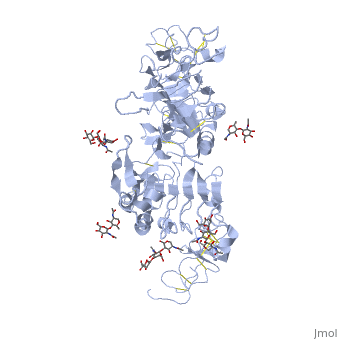MAPK/ERK pathway: Difference between revisions
No edit summary |
No edit summary |
||
| Line 42: | Line 42: | ||
===Regulation of translation and transcription=== | ===Regulation of translation and transcription=== | ||
One effect of MAPK activation is to alter the translation of mRNA to proteins. | One effect of MAPK activation is to alter the translation of mRNA to proteins. | ||
====MAPK phosphorylates the 40S [[ribosomal protein S6 kinase]] (RSK). RSK phosphorylates ribosomal protein S6. | ====MAPK phosphorylates the 40S [[ribosomal protein S6 kinase]] (RSK). RSK phosphorylates ribosomal protein S6.==== | ||
</StructureSection> | </StructureSection> | ||
== References == | == References == | ||
<references/> | <references/> | ||
Revision as of 17:05, 17 February 2022
Under development!!! MAPK/ERK pathway (also known as the Ras-Raf-MEK-ERK pathway) is a chain of proteins in the cell that communicates a signal from a receptor on the surface of the cell to the DNA in the nucleus of the cell. Cell surface receptors that can activate this pathway via GRB2Epidermal Growth Factor Receptor (EGFR; see also Epidermal growth factor). EGFR belongs to Receptor tyrosine kinases, class I. Trk A/B: High affinity nerve growth factor receptor (TrkA). TrkB tyrosine kinase receptor. See also Neurotrophin. Fibroblast growth factor receptor Platelet-derived growth factors and receptors Growth factor receptor-bound proteinsGrowth factor receptor-bound proteins (GRB) are adaptor proteins. GRBs contain SH2, Ras-associated (RA) and pleckstrin homology (PH) domains. For additional details on GRB10 see Grb10 SH2 Domain. Rho guanine nucleotide exchange factorRas activationAllosteric modulation of H-Ras GTPase. Kinase cascadeRAF kinaseB-Raf is related to retroviral oncogenes and participates in cellular signal transduction. B-Raf domains include the kinase domain - residues 444-721 and Ras-binding domain - residues 153-237. Mutated B-Raf was found in some human cancers[1]. See more in B-RAF with PLX4032. c-Raf is part of the MAPK pathway. c-Raf domains include the kinase domain - residues 323-618, cysteine-rich domain – residues 136-187 and Ras-binding domain - residues 51-132. Mutations of c-Raf are possible causes of Noonan syndrome[2]. For details on c-Raf see Molecular Playground/C-Raf. Mitogen-activated protein kinase kinase kinase MAPKs
Targets for phosphorylation by MAPKsOne of the first proteins known to be phosphorylated by ERK was a microtubule-associated protein (MAP)Regulation of translation and transcriptionOne effect of MAPK activation is to alter the translation of mRNA to proteins. MAPK phosphorylates the 40S ribosomal protein S6 kinase (RSK). RSK phosphorylates ribosomal protein S6. |
| ||||||||||
ReferencesReferences
- ↑ Brose MS, Volpe P, Feldman M, Kumar M, Rishi I, Gerrero R, Einhorn E, Herlyn M, Minna J, Nicholson A, Roth JA, Albelda SM, Davies H, Cox C, Brignell G, Stephens P, Futreal PA, Wooster R, Stratton MR, Weber BL. BRAF and RAS mutations in human lung cancer and melanoma. Cancer Res. 2002 Dec 1;62(23):6997-7000. PMID:12460918
- ↑ Antony R, Emery CM, Sawyer AM, Garraway LA. C-RAF mutations confer resistance to RAF inhibitors. Cancer Res. 2013 Aug 1;73(15):4840-51. doi: 10.1158/0008-5472.CAN-12-4089. Epub, 2013 Jun 4. PMID:23737487 doi:http://dx.doi.org/10.1158/0008-5472.CAN-12-4089
